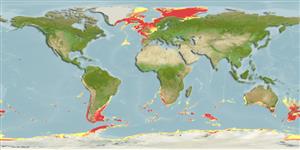Ascidiacea |
Phlebobranchia |
Corellidae
Environment: milieu / climate zone / djupintervall / distribution range
Ekologi
; djupintervall 0 - 1376 m (Ref. 1662). Subtropical
Atlantic Ocean, Indo-Pacific, Antarctic and the Mediterranean. Tropical to polar.
Length at first maturity / Size / Weight / Age
Könsmognad: Lm ? range ? - ? cm Max length : 24.0 cm TL hane/ej könsbestämd; (Ref. 1753)
Minimum depth from Ref. 3435. Lives on hard (Ref. 1744) and soft substrate (Ref. 1753), like rock, sand, mud, under rocks, and is epibiotic on other ascidians, macroalgae, or mussels (Ref. 87801) on port or harbour structures like pilings or hulls of ships (Ref. 87801, 1134), at depths of 20 to 30 m, and on moraine deposits (Ref. 1753).
Life cycle and mating behavior
Könsmognad | Reproduktion | Lek | Eggs | Fecundity | Larvae
Members of the class Ascidiacea are hermaphroditic; both cross- and self-fertilization is typical. Life cycle: Eggs develop into lecithotrophic larva before metamorphosing into benthic adults.
Sanamyan, K.E. and N.P. Sanamyan 1999 Some benthic Tunicata from the southern Indo-Pacific Ocean. Journal of Natural History 33:1835-1876. (Ref. 1662)
IUCN Red List Status
(Ref. 130435: Version 2025-1)
CITES status (Ref. 108899)
Not Evaluated
Not Evaluated
Threat to humans
Human uses
| FishSource |
Verktyg
Ytterligare information
Trophic EcologyFood items (preys)
Födosammansättning
Födointag
Predatorer
Population dynamicsTillväxt
Max. ages / sizes
Length-weight rel.
Length-length rel.
Length-frequencies
Mass conversion
Abundans
PhysiologySyreförbrukning
Human RelatedStamps, coins, misc.
Internet-källor
Estimates based on models
Preferred temperature
(Ref.
115969): 0.2 - 9.6, mean 2.4 (based on 1969 cells).
Fishing Vulnerability
Low vulnerability (14 of 100).
Price category
Unknown.
